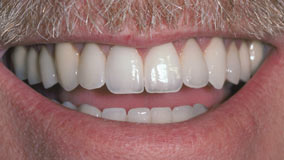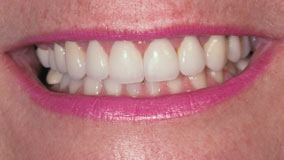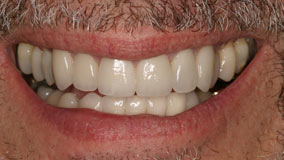Porcelain All-Ceramic Crowns
Teeth that have extensive tooth structure loss and or have had root canal therapy will often require a full coverage porcelain crown. These are made with a hard ceramic core and hand layered
Dr. James Miller can restore teeth with porcelain crowns, veneers and composite tooth-colored fillings. These can restore the tooth to optimal beauty and strength.
Teeth that have extensive tooth structure loss and or have had root canal therapy will often require a full coverage porcelain crown. These are made with a hard ceramic core and hand layered porcelain. Full gold crowns or gold onlays may also be used.
For front teeth that have significant tooth enamel left, highly esthetic porcelain veneers are the restoration of choice. They are often the restoration of choice to lengthen badly worn and shortened front teeth for function and esthetics.
Care should also be taken to verify that no interferences or imbalances are introduced because of the new restoration. Dr. Miller also attempts to identify and eliminate any existing interferences and imbalances on the models of the patient’s teeth and when appropriate on the patient’s actual teeth.
Care should also be taken to verify that no interferences or imbalances are introduced because of the new restoration. Dr. Miller also attempts to identify and eliminate any existing interferences and imbalances on the models of the patient’s teeth and when appropriate on the patient’s actual teeth. This is important to stop any additional wear to the enamel as well as gum recession and TMJ issue.
Contact Portland’s Dental Implant Specialist, Dr. James A. Miller today. He can help you to choose the best dental crown for your needs!
To prepare the tooth for a crown, it is reduced so the crown can fit over it. An impression of prepared teeth and gums is made and sent to the lab for the crown fabrication. A temporary crown is fitted over the tooth until the permanent crown is made. On the next visit, Dr. Miller removes the temporary crown and cements the permanent crown onto the tooth.
Yes. Dr. Miller’s goal is to create crowns that look like beautiful natural teeth. To achieve a certain look, a number of factors are considered, such as the color, bite, shape, and length of your natural teeth. Any one of these factors alone can affect your appearance.
If you have a certain cosmetic look in mind for your crown, discuss it with us at your initial visit. When the procedure is complete, your teeth will be stronger, more comfortable and exceptionally beautiful.
Crowns require more tooth structure removal, hence, they cover more of the tooth than veneers. Crowns are customarily indicated for teeth that have sustained significant loss of structure, or to replace missing teeth. Crowns may be placed on natural teeth or on dental implants.
There is no difference between a cap and a crown.
Crowns should last at a minimum of 5-8 years. However, with good oral hygiene and supervision, excellently fabricated crowns can last decades. Some damaging habits like grinding your teeth, chewing ice, or fingernail biting may cause this period of time to decrease significantly. That is why we always evaluate your bite prior to making any permanent restoration in your mouth. We may mount a set of your models of your teeth on a special articulator to correctly diagnose how to improve your bite, or we may recommend that you see an orthodontist to have your bite correctly fixed prior to restoration with crowns.
To prevent damaging or fracturing the crowns, avoid chewing extremely hard foods, ice or other hard objects and using your teeth as tools to cut or open things. You may also want to avoid teeth grinding. Besides visiting your dentist and brushing twice a day, cleaning between your teeth is vital with crowns. Floss or inter-dental cleaners (specially shaped brushes and picks) are important tools to remove plaque from the crown area where the gums meets the tooth. Plaque in that area can cause dental decay and gum disease.
There are dentists who utilize a technology to fabricate a crown while you wait, while this technology is interesting it has several limitations. The first being that it only restores your tooth to what it looked like just before the procedure, this means if your natural tooth structure has been lost over time due to pathology in your bite, this technology will not correct this less than ideal function and esthetics. Another limitation is the precision in the margins of the crown (where the edge of the crown meets the tooth), minute deficiencies in this area can lead to failure of the crown much sooner.
One limitation is that the restoration fabricated for your tooth can only be made to look like your original worn out tooth. Another limitation is the poor precision or fit of the margins of the crown (this is where the edge of the crown fits to the tooth). Deficiencies in this area can lead to early failure of the crown due to leakage and decay.




